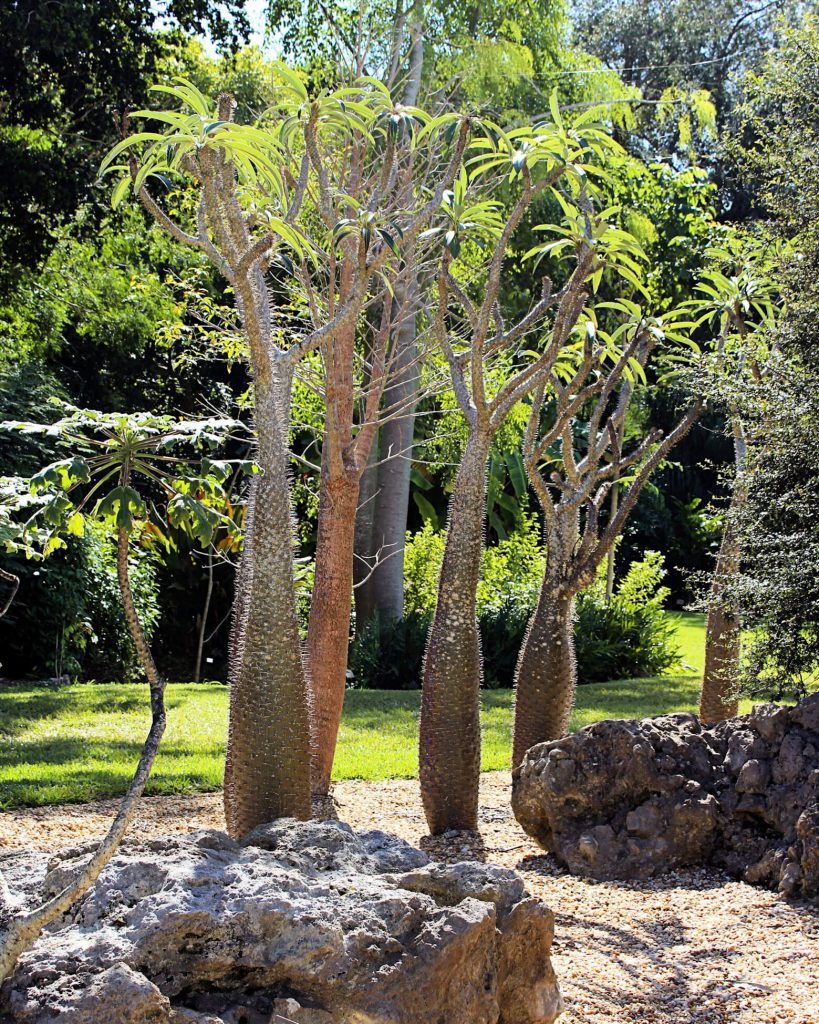By Ralph E. Mitchell

When I was a child, I remember buying a tiny three-inch tall plant selected from a tray of succulents at a five-and-dime store – circa 1970. I was thrilled with this new and exotic plant I had never seen before. As it turned out, it was my first Madagascar palm, a type of succulent. It was a “palm in name only”, but at a glance, a good name for this Madagascar native!
The Madagascar palm looks like a palm as it has a long, leafless trunk. However, this silver-green trunk is covered in a coat of sharp spines suitable to repel and injure all comers. The trunk, actually allowing for the majority of the plant’s photosynthesis, eventually develops a swollen nature giving it an especially thickened, fat appearance. At the top of this potentially ten-foot tall plant is a crown of long, narrow leaves that further adds to the palm-like structure. At maturity, clusters of white flowers will also appear in the summer. As the Madagascar palm is related to Plumeria, you will notice the similarities of the flowers in shape, size and fragrance. While mostly single-trunk in nature, I have seen several multibranched specimens which are especially eye-catching.
A few Madagascar palms are in our local landscapes and they are real conversation pieces. Best grown in hardiness zone 10, Madagascar palms can make nice container plants which will allow them to be moved in case of a freeze in otherwise marginal environments. This is a plant from arid regions that do best in full sun and well-drained sandy soil. Embrace your sandy soil with this plant! In addition to be drought-tolerant, it is also moderately salt-tolerant. During the winter, most, if not all of its leaves will drop. This is perfectly normal and new growth will commence in the spring.
Water is perhaps the biggest enemy of Madagascar palms – don’t over-water as rots will set in. These rots can be fatal!
Madagascar palms can slowly grow to twenty-feet tall, but this takes a long time as growth slows with age. Be careful where you place these as passersby – both people and pets – can be hurt by the spines. If size is an issue, there is a dwarf Madagascar palm cultivar called ‘Ramosum’ which would be ideal for containers and small rock gardens. There is even a variety that is called the Crested Madagascar palm which has gnarly, distorted, but “beautiful” growth that only a mother or plant collector could love!
Try this succulent and other Pachypodium species for something different in your yard or patio! For more information on all types of unique plants suitable to both the collector and backyard gardener, or to ask a question, please visit https://www.facebook.com/CharlotteMGLifeline/. Ralph E. Mitchell is the Director/Horticulture Agent for the UF/IFAS Charlotte County Extension Service. He can be reached at 941-764-4344 or ralph.mitchell@charlottecountyfl.gov.
Don’t forget that Florida-Friendly Landscaping™ is a program that our office encourages as it promotes planting the “right plant in the right place”, water conservation, common sense pest management, sensible use of fertilizers, composting, etc. that help develop a sustainable landscape. For more information on this important, over-arching program, please contact Sara Weber, FFL Education-Training Specialist, at Sara.Weber@charlottecountyfl.gov .
Resources:
Landre, C; (2020) Madagascar Palm. South Florida Plant Guide.
Stein, G. (2012) Pachypodiums- The caudiciform collectors plant- Introduction to the species and cultivational suggestions. Dave’s Garden https://davesgarden.com/guides/articles/view/539.
World of Succulents. (2020) Pachypodium lamerei f. cristata (Crested Madagascar Palm). https://worldofsucculents.com/pachypodium-lamerei-madagascar-palm-club-foot/
https://en.wikipedia.org/wiki/Pachypodium_lamerei
 1
1
